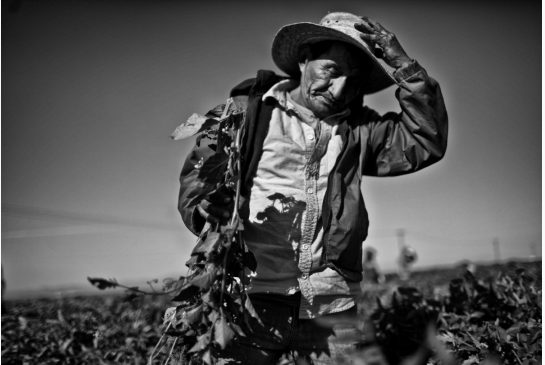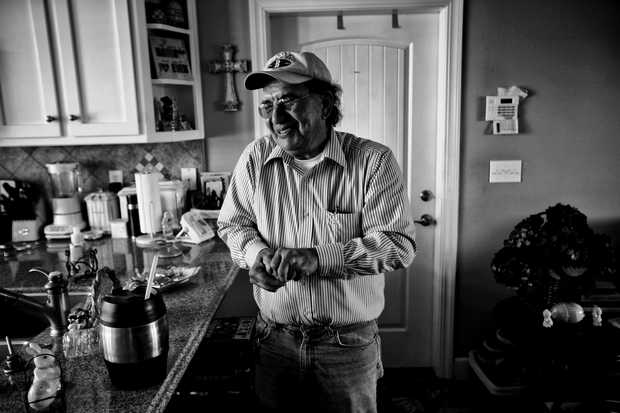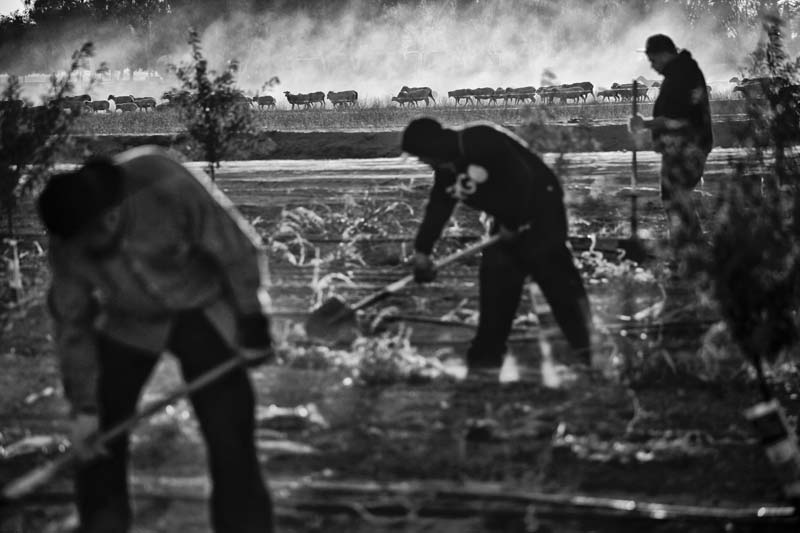"My parents died when I was young. I didn’t get through college. I didn’t have any of the right credentials," she says. "But I could write. People seemed to think I could write."
That certainly was the judgment of the Pulitzer Prize Board, which last week awarded her the 2015 prize for feature writing for her series of stories in the Los Angeles Times about the impact of the drought on people living in California's Central Valley.

Marcum, 52, had freelanced for the Los Angeles Times on and off for years before being hired as a staff writer in 2011. She covers the 900-square-mile Central Valley for the newspaper and pursued the drought stories in between chasing fires and the other news a beat reporter has to manage. And while she and photographer Michael Robinson Chavez knew from the beginning that they wanted to explore the impact of the drought in a serious and sustained way, the series never carried the self-important imprint of a capital-P "Project." The pair just went out, looked for stories and found them.
She wrote the pieces late at night at her dining-room table, fueled by Diet Coke and a copy of John Steinbeck's "The Grapes of Wrath," a gift from her editor that she set out to remind herself of the stakes of doing her subject justice.
We talked by phone as Marcum sat on her front porch in Fresno, where our conversation was momentarily interrupted by the arrival of a congratulatory bouquet of flowers and Marcum's friendly chat with her mail carrier, whom she knows by name. What follows is an edited and condensed transcript.
How did the drought stories come about?
I cover the Central Valley. I live here, and where the drought was hitting wasn’t the city. It was out in the little towns and the farms, way far off the road. You can’t just go around and knock on doors. It’s pretty hard to just find the doors. This was an area where life is hard and people are incredibly resilient and there’s just these stories of just trying to make your way in the world. Little stories that fascinate me. I mean they’re not little stories, but they’re little-told stories.
I had already been driving around and going to all these little places because we were thinking about doing a series of stories on people who were hungry in the middle of the bread basket. And then we started seeing the drought hit. And remember, these stories were written about a year before anybody was paying attention to the drought. So that was how it started. We just started talking to people and seeing where the drought was hitting and it was in pockets. Like you could even go to a town, and you could talk to the first people you saw and they’d say, “Oh we’ve been fine, we all found jobs, we’re still farming.” But it’s because of California’s weird water rights, right? You could go three blocks away and there was a whole neighborhood of people out of work. So you had to really, really look.
You and the photographer, Michael Robinson Chavez, had envisioned from the beginning that it would be a series. Did you think of it in any more specific terms than that?
We started with the most vulnerable. We started with the farm workers who didn’t have papers. We did that story. And then, oh my goodness, you know, this is so much worse than we realized. And then we just kind of worked our way up. We started with the farm worker, then we did the small farmer. By then, a whole entire town was out of water. So we went there and then the land was sinking, so we found a small town where the land was sinking. It was always just kind of following the journalism gods.
These people are in really difficult circumstances but they opened up to you. How did you gain their trust?
We just go out and make friends. It takes a little bit of time. We hang out, we just sort of invite ourselves in, and we eat samosas with the Singh family, and say, “Oh, can we look at your almond tree?” And we do a lot of listening, maybe to things that would never end up in the story. People really want to talk, you know. I mean we all do. You know when you find someone that will really listen to you, most people appreciate that opportunity. I know I do.

Talk a little bit more about your relationship with your photographer. It sounds like you were together on this from the get-go.
Oh yeah, very much so. He’s very well-traveled, and he loves food, and he’s just charming. So he’s very good at talking to people, striking up a conversation. You know, if they’re from Yemen, he covered a story in their hometown. He always seems to have some touchstone with people, which is really handy. And I think he’s the more driven one of us. He’s the more, “Oh this is a national news story, this is gonna be a series.” And I’m more the writer, just kind of feeling it out as I go and thinking about exactly what’s in front of me in that moment. I think we make a good team.
I think that the other thing that’s kind of interesting about us working together is that our stuff doesn’t match. We work together in that we’re finding the people and figuring out the stories, but we’re not the kind of team where we’re telling the same story. There’s always some quirky side element to his photographs. I mean, you’ll see the certain farmer leaning on the fence and the dry landscapes, but there’ll always be a kid in the corner playing the trumpet or something. Which is I think pretty much how I write. So it’s interesting when I finally see his pictures and he finally sees my stories, and we saw such different things, but we saw the same overall story.
Walk me through the reporting process. How long were you out in the field? How long did the stories take to write? What were some of the challenges putting it together?
I think that where most of the time gets used is walking around and just talking to people. It’s interesting because I don’t know when I’m talking to people a lot of the time that that’s going to be part of the story. I find that what’s in my notebook is not what goes in the story. There’s like some back part of my brain that’s videotaping everything we do and later on, those are the things that I suddenly realize are key when you start putting it together in your mind.
How long did it typically take you to write a story?
Central Valley is my beat, and we were keeping it to ourselves that we had some grander vision. So we had not a lot of time to work on them. I would say a couple of weeks maybe.
So it’s not as though someone was saying to you, an editor was saying, “Go off for six months, Diana, and tell the story of the drought."
No, not at all. I was covering fires and everything else. We still had our regular work to do. Which I kind of like, you know? I mean it’s so exciting winning the Pulitzer… I just wasn’t sure how a newspaper reporter who covers 900 square miles on top of trying to do this would ever compete with magazine writers that have a whole year to work on a story. So secretly I’m kind of jazzed.
The stories are very highly focused, without a lot of outside experts or data, etc. Did you have to fight for that approach?
Well, these stories ran in Column One. And Column One is this tradition at the Los Angeles Times. I’ve been reading it since I was a child. So there’s always been a place on the front page of the Los Angeles Times for stories that were quirky or sad or just full of humanity, just full of life. Just stories that were interesting to read. I think that we’ve not even ever defined it any more narrowly than that because we want them to run the gamut, right? I mean, they just have to be interesting. They have to be special. They have to be different. And that’s it. Just have at it, you know?
The LA Times has this umbrella that allows storytelling. I mean real storytelling, where you take somebody into a world and keep them there from the beginning to the end, and the main thing is about the characters and the feelings. And now it’s not like you’re going to be telling a story and then interrupt yourself and say, “Oh, and let me explain the history of almonds in California.” It breaks things up. That’s why it doesn’t work if too many fingers get in the pie. And I’m not talking about the paper I’m at now. I think that any feature writer has been through that thing where they start deciding they need two graphs of this and three graphs of that. And the story gets lost.
What was the editing process like?
It’s a dream. It’s just a dream, a dream come true. When you finally, finally meet somebody who’s like-minded. Kari Howard is the Column One editor. I’m a state reporter so it goes through the regular editing process with Steve Clow. He’s the state editor. He’s more hard-news minded. So he’s looking for facts, kicking the tires, which is great. And then it goes to Kari. And we’re reading the lines out loud, and we’re weighing connotations… We’re having a very back-and-forth conversation. It’s not that kind of editing where, “Oh, here’s my changes. Take a look and see what you think.” It’s like, “Well, I think you’re missing a beat here… Oh I see what you’re saying. Why don’t we move this line here? Oh yeah, we did that, but do you think we have too much of this?”
It’s very back and forth. We’re almost like those chipmunks from the Disney cartoons, you know? It’s very respectful and very warm, and we’ve developed a friendship from working together on so many stories. So we can almost complete each other’s sentences at this point. And sometimes if something isn’t working, we’ll say, “Let’s take a pass at this and see what you have.” And we’ll come back the next day and find out we changed the exact same things.
What did change in the stories and what didn’t, from start to finish?
Well, the leads and the ends hardly changed. I mean if you have your beginning and your end, sometimes, things move around in the middle in service of those two things. But as long as you know for sure this is where we have to start and this is where we have to end, then you’re home.
Do you start with the beginning or do you start with the end or do you start somewhere in between?
Ugh, it’s really my weak point. But I start at the beginning and I go to the end. Certainly, when I was a younger reporter, and editors are trying to hurry you up, and they always say, “If you don’t have your lead, just go write something else.” No.
You know, I have to have the blank page, and I can’t do anything until I have my lead. I have to really believe in the lead to at least get everything else on paper. Even if it changes later, you know? I’m not suggesting it for other writers, but for me personally, I’m a top-to-bottom kind of person.
One of the things I thought was really striking about these stories was the use of detail and imagery. For example, there’s a line in one story, about two girls, “a tangle of giggles.” I would love to hear about your process. Do you just see those things and put them in your notebook? Do you have to work at it?
I’m a night owl. So I’m usually writing at two o’clock in the morning with a Diet Coke, you know, getting a little punchy. And I’m usually playing the scenes in my mind. I’m seeing things. I’m kind of replaying. I’m watching what happened in my head. And a lot of times what ends up in the story is not what ended up in my notebook. I think it comes more from those mental images. And I was thinking about Francisco’s daughters, and I just typed “a tangle of giggles.” I just typed it. And I remember it just came out of nowhere. I remember feeling delighted. You know that feeling like, “Oh! I like that.”
There are some light moments in these stories, too.
Always.
Why do you feel it was important to include those?
I think my overall purpose was to introduce people to each other, to let them get to know one another. And I think how we bond with each other is through laughter. Like, the people we like to be with are the people whose sense of humor we share. I mean that’s how you make friends with people, like when you’re traveling. If you can share a little laugh with someone, that’s what breaks the ice and makes you feel a little comfortable.
There’s a saying. I don’t remember who said it, but my dad used to say it a lot: “Angels can fly if they take themselves lightly.” I think that’s true for a story, too. When you’re talking about something that’s very wrenching and has a lot of pathos, if it’s just all the grit and despair, it’s not servicing telling the reality because the kind of people that I’m writing about are very resilient, and they have humor. And there’s something to be admired there. And it usually comes through in the lighter moments. And you don’t care as much about the dark unless there’s at least a little pinpoint of light.

I described the stories as quiet because they feel understated. There are moments, like when Fred Lujan starts crying, that other writers might have been tempted to really blow out or overdramatize. But you didn’t feel the need to gussy it up.
Oh, God no. Well, extraneous things never add power. Power comes from essence, right?
What was the moment like when you heard you had won the Pulitzer Prize?
When they said my name, I just did that thing you do when you’re a kid. I closed my eyes to make sure I wasn’t dreaming. Because when you’re a kid and you want to check if something’s real, you know how you just close your eyes for a minute? And then it was a whirl and I was happy and there were speeches and there was champagne.
Why do you think these particular stories resonated both with the Pulitzer Board and readers?
I’m of a divided mind on that. Because I always worry that no one’s going to be interested in reading them. You could argue that nothing happens. I mean my editor Davan [Los Angeles Times editor-in-chief Davan Maharaj] — his favorite story in the series is the one with the farmer who gives the water to his neighbors. And he says it’s his favorite story where nothing happens. So I guess there’s a part of me that always expects, and always does get some of those letters saying, “What’s this doing on the front page?” And then they’ll run down the list of news that day that they find far more important. I don’t know why it resonated, but I feel that it’s such a validation of this writing that it did. It just makes me so happy to think that there are stories whose main purpose is just to introduce people and make them understand a certain way of life or make them feel like they know this person.
That’s narrative, right? That’s what narrative does.
Right, exactly. That’s what narrative does. So at least this kind of narrative. Even though they’re very sad stories and very tragic circumstances, people will write me and say, “You know, I was having such a bad day, and then I read about this guy. And it made me want to do something kind for someone.” I get these “Thank you for the story” notes. And I am really the wrong person to be thanking; I’m just telling the story. But you get the privilege of being the go-between, of saying, “Hey, this is part of the world too.” If we only write about the bad, that’s not a complete picture.There is a lot of perseverance and faith and friendship and humor. There’s everything. It’s a big, complex world of good and bad. And the good counts.



